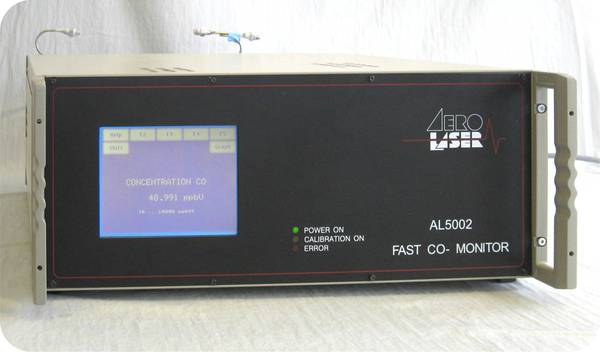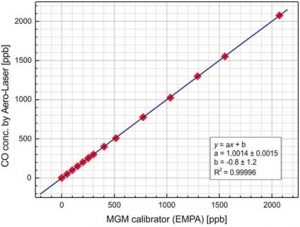Instrument Support Level 2
Aerolaser, AL5002
ncas-aerolaser-co-2
co-concentration
£40,000
45 cm x 18 cm x 59 cm. 22kg
See page for details
£20
Calendar

Aerolaser AL5002 CO Monitor
The AL5002 from Aero-Laser is a fast carbon monoxide (CO) monitor with a unique sensitivity below 1ppb (parts per billion).
The detection of CO is based on a VUV-fluorimetry, employing the excitation of CO at 150nm.
This method combines high sensitivity with high selectivity and is linear from 1ppb to 100 ppm. The excitation light is generated by a CW-CO2 resonance lamp, which needs only low maintenance. A monochromator unit, using dielectric mirrors, filters out the VUV from the lamp’s spectrum.
The fluorescence light in the wavelength range between 160 nm and 190 nm is detected by a VUV sensitive photomultiplier followed by a fast counter.
The AL5002 calibrates within minutes, using only a small amount of calibration gas and an in-built zero gas source.
The calibration procedure is fully automatic and can be scheduled in custom-set time intervals.
The gas concentration is displayed in real-time and is logged via a standard RS-232 interface.
Parameter/diagnostic information (e.g. of pressures, flows, temperatures) are logged simultaneously with the measurement data allowing fast troubleshooting of problems.
The instrument consists of a resonance CO2-lamp excited by an RF discharge, an optical filter for selection of the appropriate wavelength interval around 150 nm, and a fluorescence chamber. The emission of the lamp is collimated within the optical filter to a parallel beam of 150 nm light, using off-axis parabola and dielectric mirrors. The VUV-light is then focused on the fluorimeter chamber, where the fluorescence from CO is viewed at right angles by a VUV-sensitive photomultiplier (PMT) with Suprasil pre-optics. The dielectric mirrors in the parallel part of the light beam, provide the spectral band path (bandwidth of ~10 nm full width at half maximum (FWHM) at approximately 150 nm). The optical filter is continuously flushed with dry N2 (purity of 6.0 and filtered to compress organic substances) which is necessary to avoid absorption of radiation in the Schumann-Runge continuum of molecular oxygen and from impurities, in particular, CO. This only requires a flow of ca. 35 ml/min N2 since the volume is very small. The optical filter housing is made from Al covered with a black coating for the reduction of stray light. The air is vented into the fluorimeter chamber, which is connected to an external vacuum pump at the end of the light trap and at the PMT flange, in order to provide well-defined airflow. A pressure sensor and an electrically driven dosing valve stabilize the pressure and the airflow through the cell.
The basic principle is described in detail by Gerbig et al. [1].
[1] C. Gerbig, S. Schmitgen, D. Kley, A. Volz-Thomas, K. Dewey, D. Haaks, An improved fast-response vacuum-UV resonance fluorescence CO instrument, J. Geophys. Res. 104 D1 (1999) 1699
Calibration of CO is performed with reference to a single gas standard containing a known amount of CO. It is well understood that the instrument behaves linearly.

Calibrations are performed every 24 hours but can be done more frequently during intensive periods of COZI –Laboratory use. The data is applied to the subsequent 24 hours of measurements. The data is quality assured and if step changes are observed in the concentration data (e.g. due to humidity effects) then data is recalibrated or rejected accordingly. Instrument parameters (temperatures, flows, and gas pressures) are logged alongside those of the concentrations and used to diagnose problems. Instrument sensitivity is monitored and when it drops below 15Hz/ppbV a thorough cleaning of the instrument is performed.
The carbon monoxide measurements are fully traceable to the international Global Atmospheric Watch (GAW) scale (currently NOAA/ESRL WMO-2000). This means that the gas calibration standards used to calculate the final concentrations are referenced to a common standard held at the NOAA/ESRL laboratory.
Costs
- Instrument Insurance
- This system must be insured by the user for £40K and covers loss, theft or damage to the instrument: damage is that over and above general wear and tear. The system has been designed to be rugged and autonomous. Even so, the end-user must respect the fact that the system is a precision optical instrument that must be treated with great care.
- The user is responsible for the instrument from the time it leaves the AMOF to the time it is returned and signed off as in an acceptable operating condition by the IS: this will be done as soon as is possible on its return.
- Public Liability Insurance
- The AMOF is not liable for any damage or injury arising from the deployment or operation of this instrument when unattended by the IS.
- Shipping Expenses
- The user is liable for all costs arising from the shipping of the instrument both to and from a deployment.
- IS T&S
- The user is responsible for coving the travel and subsistence expenses of the IS while attending the instrument.
Shipping
Please contact the IS to discuss shipping.
The instrument needs to be housed in a dry environment that does not exceed the environmental conditions as detailed in the specifications. The instrument should be situated on a level surface.
Instrumental Hazards
- All the instruments are self-enclosed so many of the potential hazards from the instruments are reduced.
Electrical Hazards
- All instruments must be powered down before any maintenance can be performed.
- All electrical devices must be checked and certified.
- Operators must have knowledge of the location of exposed electrical connections.
- Ensure instruments are earthed at all times.
Dimensions:
- 45 cm (W) × 18 cm (H) × 59 cm (D)
Weight
- 22kg
Electrical
- 110 VAC / 220VAC
Power
- <100W
The data product would be a time series of CO mixing ratio. The data cycle is 210 seconds, with the sample being representative of the 60 seconds previous to the time stamp
Field Data
- The instrument produces a range of out files and all are text format.
- The user can download (but not delete) this data from the instrument but it should be noted that this data will not have been quality controlled.

Archive Data
- Data is provided in NetCDF files following the AMOF data standard
- Files contain no more than 24hr of data.
- Instrument name is
- ncas-aerolaser-co-2
- The data product(s) associated with this instrument:
- Example data file
